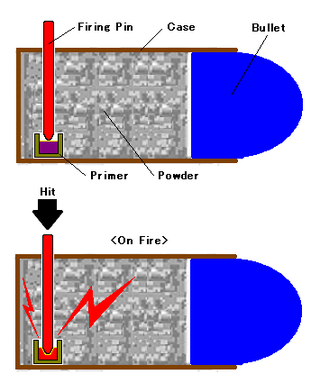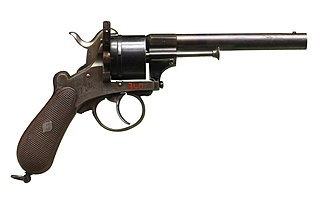
A revolver is a repeating handgun that has at least one barrel and uses a revolving cylinder containing multiple chambers for firing. Because most revolver models hold up to six cartridges, before needing to be reloaded, revolvers are commonly called six shooters or sixguns. Due to their rotating cylinder mechanism, they may also be called wheel guns.

A cartridge, also known as a round, is a type of pre-assembled firearm ammunition packaging a projectile, a propellant substance and an ignition device (primer) within a metallic, paper, or plastic case that is precisely made to fit within the barrel chamber of a breechloading gun, for convenient transportation and handling during shooting. Although in popular usage the term "bullet" is often used to refer to a complete cartridge, the correct usage only refers to the projectile.

The pepper-box revolver or simply pepperbox is a multiple-barrel firearm, mostly in the form of a handgun, that has three or more gun barrels in a revolving mechanism. Each barrel holds a single shot, and the shooter can manually rotate the whole barrel assembly to sequentially index each barrel into alignment with the lock or hammer, similar to rotation of a revolver's cylinder.

A breechloader is a firearm in which the user loads the ammunition from the breech end of the barrel, as opposed to a muzzleloader, in which the user loads the ammunition from the (muzzle) end of the barrel.

The Webley Revolver was, in various designations, a standard issue service revolver for the armed forces of the United Kingdom, and countries of the British Empire and the Commonwealth of Nations, from 1887 to 1970.

Ethan Allen was a major American arms maker from Massachusetts. He is unrelated to the revolutionary Ethan Allen. His first firearm, the "Pocket rifle" was developed in 1836, and his first patent was granted in 1837.

The pin-fire is a type of metallic cartridge used in firearms, where the priming compound is ignited by striking a small pin that protrudes radially from above the base of the cartridge. Invented by Frenchman Casimir Lefaucheux in 1832, but not patented until 1835, it was one of the earliest practical designs of a metallic cartridge to hasten the loading and firing process of a firearm. Its history is closely associated with the development of the breechloader, which would eventually replace all muzzle-loading firearms.

The Remington M1867 is a rolling-block rifle that was produced in the second-half of the 19th century. It was the first rifle using metallic cartridges to be adopted by the Norwegian and Swedish armies. Nominally, it had a caliber of 4 decimal lines, but the actual caliber was 3.88 Norwegian decimal lines or 4.1 Swedish decimal lines (12.17 mm), and it fired a rimfire round with a 12.615 mm lead bullet. The 12.17 mm caliber was chosen because the Swedish army had approximately 30,000 new muzzle-loading M1860 and breech-loading M1864 rifles in 12.17 mm caliber in stock, rifles that were suitable for conversion to M1867 rolling-block rifles. With the exception of the first 10,000 rifles and 20,000 actions, which were made by Remington in the US, all Remington M1867 rifles and carbines were made under license in Norway and Sweden, by Kongsberg Vaapenfabrik in Norway, and by Husqvarna Vapenfabriks Aktiebolag and Carl Gustafs stads Gevärsfaktori in Sweden with the two Swedish manufacturers producing about 80% of the weapons.

A pistol sword is a sword with a pistol or revolver attached, usually alongside the blade. It differs from a rifle with a bayonet attached, in that the weapon is designed primarily for use as a sword, and the firearm component is typically considered a secondary weapon designed to be an addition to the blade, rather than the sword being a secondary addition to the pistol. In addition, the two components of these weapons typically cannot be separated, unlike most bayonets mounted on rifles.

The LeMat revolver was a .42 or .36 caliber cap & ball black powder revolver invented by Jean Alexandre LeMat of France, which featured an unusual secondary 16 to 20 gauge smooth-bore barrel capable of firing buckshot. It saw service with the armed forces of the Confederate States of America during the American Civil War of 1861–1865 and the Army of the Government of National Defense during the Franco-Prussian War.
Auguste Francotte&Comp. was a privately owned firearms manufacturer based in Liège, Belgium. It was founded between 1805. and 1810, and was still in operation after 1948.

The Nagant M1895 is a seven-shot, gas-seal revolver designed and produced by Belgian industrialist Léon Nagant for the Russian Empire.

The Smith & Wesson Model 10, previously known as the Smith & Wesson .38 Hand Ejector Model of 1899, the Smith & Wesson Military & Police or the Smith & Wesson Victory Model, is a K-frame revolver of worldwide popularity. In production since 1899, the Model 10 is a six-shot, .38 Special, double-action revolver with fixed sights. Over its long production run it has been available with barrel lengths of 2 in (51 mm), 3 in (76 mm), 4 in (100 mm), 5 in (130 mm), and 6 in (150 mm). Barrels of 2.5 inches (64 mm) are also known to have been made for special contracts. Some 6,000,000 of the type have been produced over the years, making it the most-produced handgun of the 20th century.

In firearms, the cylinder is the cylindrical, rotating part of a revolver containing multiple chambers, each of which is capable of holding a single cartridge. The cylinder rotates (revolves) around a central axis in the revolver's action to sequentially align each individual chamber with the barrel bore for repeated firing. Each time the gun is cocked, the cylinder indexes by one chamber. Serving the same function as a rotary magazine, the cylinder stores ammunitions within the revolver and allows it to fire multiple times before needing to reload.
Casimir Lefaucheux was a French gunsmith. He was born in Bonnétable, France and died in Paris, France.

The Lefaucheux M1858 was a French military revolver developed for the navy, chambered for the 12 mm pinfire cartridge, and based on a design by Casimir Lefaucheux and his son, Eugene. The 1854 model was the first metallic-cartridge revolver adopted by a national government; the 1858 was the first variant fielded. It was first issued in 1858 by the French Navy, and though never issued by the French Army, it was used in limited numbers by the French Cavalry during their 1862 deployment to Mexico.
The Henrion, Dassy & Heuschen double-barrel revolver was a type of revolver with two stacked barrels and two concentric sets of chambers, each serving its own barrel. They were fired by a single hammer which had two firing pins. The chambers were staggered, such that the gun fired only round at a time. These revolvers were based on a 1910 patent held by the Belgian firm of Henrion, Dassy & Heuschen (HDH), and were made in various calibers.

Rollin White was an American gunsmith who invented a single shot bored-through revolver cylinder that allowed paper cartridges to be loaded from the rear of a revolver's cylinder. Because the open breeches were unprotected from lateral fire, all charges would instantly explode in a chain fire. Only one gun would be built to White's specifications, and that for use in a trial to show the impracticality of the gun. The gun could not fire metallic cartridges.

The 12mm Lefaucheux is a metallic center-fire cartridge. It was originally created as a rimless pinfire cartridge using black powder employed by the French navy on the Lefaucheux M1858 revolver. Later it was adapted to a center-fire cartridge by the French Army in 1873 for use on the MAS 1873 revolver.

Lefaucheux-Francotte M. 71 or Revolver m/1871 was a 19th-century Belgian revolver made for Swedish military. It was also the first service revolver of the Principality of Serbia.
















